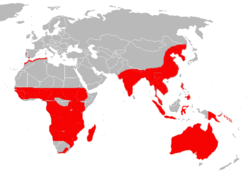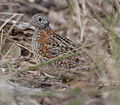Buttonquail
| Buttonquail | |
|---|---|
 | |
| Black-breasted Button-quail (Turnix melanogaster) | |
| Scientific classification | |
| Kingdom: | Animalia |
| Phylum: | Chordata |
| Class: | Aves |
| Order: | Charadriiformes |
| Family: | Turnicidae GR Gray, 1840 |
| Genera | |
Turnix
Ortyxelos | |
 | |
| Distribution of the Buttonquails. | |
Buttonquail or hemipodes are members of a small family of birds, Turnicidae, which resemble, but are unrelated to, the quails of Phasianidae. They inhabit warm grasslands in Asia, Africa, Europe, and Australia. There are 16 species in two genera, with most species being found in the genus Turnix and only one being found in the genus Ortyxelos.
Buttonquails are small, drab, running birds, which avoid flying. The female is the more brightly coloured of the sexes, and initiates courtship. Unusually, the buttonquails are polyandrous, with the females circulating among several males and expelling rival females from her territory. Both sexes cooperate in building a nest in the earth, but only the male incubates the eggs and tends the young. The eggs hatch after an incubation period of 12 or 13 days, and the young are able to fly within two weeks of hatching.
Taxonomy
Buttonquail were traditionally placed in Gruiformes or Galliformes (the crane and pheasant orders). The Sibley-Ahlquist taxonomy elevated them to ordinal status as theTurniciformes and basal to other Neoaves either because their accelerated rate of molecular evolution exceeded the limits of sensitivity of DNA-DNA hybridization or because the authors did not perform the appropriate pairwise comparisons or both. Morphological, DNA-DNA hybridization and sequence data indicate that turnicids correctly belong to the shorebirds (Charadriiformes). They seem to be an ancient group among these, as indicated by the buttonquail-like Early Oligocene fossil Turnipax and the collected molecular data.
Description
The buttonquails are a group of small terrestrial birds. The smallest species is the Quail-plover, the only species in the genus Ortyxelos, which is 10 cm (3.9 in) in length and weighs only 20 g (0.71 oz). The buttonquails in the genus Turnix range from 12–23 cm (4.7–9.1 in) in length and weigh between 30–130 g (1.1–4.6 oz). They superficially resemble the true quails of the genus Coturnix, but differ from them in lacking a hind toe and a crop. The females of this family also possess a unique vocal organ created by an enlarged trachea and inflatable bulb in the oesophagus, which they use to produce a booming call.
Species
Family: Turnicidae
- Genus: Ortyxelos
- Quail-plover, Ortyxelos meiffrenii
- Genus: Turnix
- Small Buttonquail, Turnix sylvaticus
- Tawitawi Small Buttonquail, Turnix sylvaticus suluensis (extinct: mid-20th century)
- Andalusian Hemipode, Turnix sylvaticus sylvaticus (possibly extinct: late 20th century?)
- Worcester's Buttonquail, Turnix worcesteri
- Sumba Buttonquail, Turnix everetti
- Black-rumped Buttonquail, Turnix hottentottus
- Yellow-legged Buttonquail, Turnix tanki
- Barred Buttonquail, Turnix suscitator
- Madagascar Buttonquail, Turnix nigricollis
- Spotted Buttonquail, Turnix ocellatus
- Black-breasted Buttonquail, Turnix melanogaster
- Painted Buttonquail, Turnix varius
- New Caledonia (Painted) Buttonquail, Turnix (varius) novaecaledoniae (extinct: early 20th century)
- Chestnut-backed Buttonquail, Turnix castanotus
- Red-chested Buttonquail, Turnix pyrrhothorax
- Red-backed Buttonquail, Turnix maculosus
- Little Buttonquail, Turnix velox
- Buff-breasted Buttonquail, Turnix olivii
- Small Buttonquail, Turnix sylvaticus




No comments:
Post a Comment